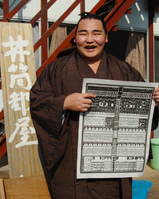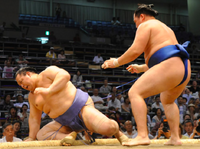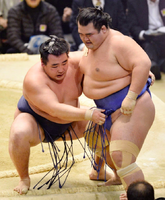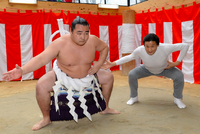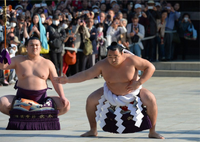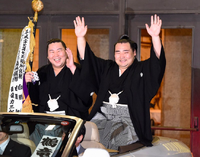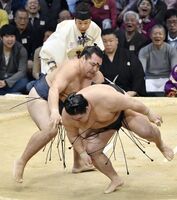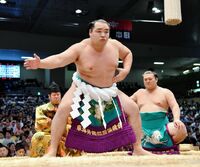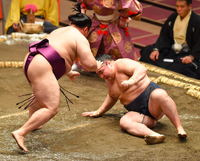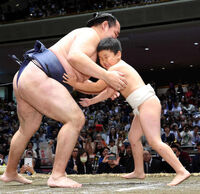Kakuryu Rikisaburo - 鶴竜 力三郎 (born August 10, 1985) is a former Mongolian professional sumo wrestler from Sükhbaatar. He made his debut in November 2001 and last wrestled for Michinoku stable. He reached the makuuchi division in November 2006 and has 9 special prizes and 6 top division championships. He was the 71st yokozuna and he retired in March 2021.
Early Life[]
Anand Mangaljalavyn was born in Ulaanbaatar, Mongolia on August 10th, 1985 (however he used his fathers hometown, Sükhbaatar, as his hometown in professional sumo). He was born into a wealthy family of university professors and played sports such as tennis and basketball as a child. He was also focused on his studies and was an honor-roll student.
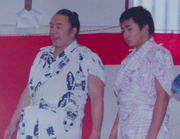
Kakuryu with veteran stablemate, Terao (c. 2001)
Due to his wealthy family environment, he could watch NHK's sumo broadcast from home and it was during that time where there was a "Mongolian Boom" in professional sumo. At age 14, he decided to devote himself to sumo after seeing a tournament featuring fellow Mongolians Kyokutenho and Kyokushuzan on TV. He at first went to a tryout for Hanakago stable, but failed. However, he was still determined to join sumo, so he asked a colleague of his father who taught Japanese at the university to help him translate a letter. He then mailed the letter to several stables in Japan. Izutsu stable's head was impressed and invited Mangaljalavyn to Japan. Mangaljalavyn's family had no background in Mongolian wrestling, and he had no experience in wrestling before coming to Japan.
Career[]
Early Career[]
When Mangaljalavyn joined Izutsu stable, he weighed just 65 kg (143 lb) and his oyakata former sekiwake Sakahoko joked he was better suited to be the stable's tokoyama (hairdresser) than a wrestler. Mangaljalavyn made his professional debut at the Kyushu Grand Sumo Tournament in November 2001 under the shikona "Kakuryu" and just weighing 82 kg (181 lb).

Kakuryu had an impressive start and breezed through the jonokuchi and the jonidan divisions. After reaching the fourth highest sandanme division fairly quickly, he struggled, being demoted back to jonidan twice. After 17 tournaments, he finally won the sandanme championship in July 2004 with a 7–0 record and earned promotion to the makushita division. Unlike sandanme, makushita wasn't too hard for Kakuryu. He suffered a make-koshi, or losing record in his debut tournament, but then he would produce six straight kachi-koshi, or winning records, which earned him a promotion to juryo for the November, 2005, tournament.
Juryo Career[]
Kakuryu first reached sekitori status in November 2005 upon promotion to the juryo division but fell short with a 5–10 record, dropping back to makushita. He returned to the second division in March 2006 and produced an impressive six straight 9-6 records to earn a promotion to makuuchi for the November 2006 tournament.
Makuuchi Career[]
He was the first wrestler from the stable to make the top division since the current stablemaster took control in 1994. One of seven wrestlers to be promoted to makuuchi for that tournament, he made his debut halfway up the maegashira ranks at number 8, the highest since Miyabiyama began at maegashira 7 in March 1999. He came through with a solid 8–7 record.

Kakuryu with the Technique and Outstanding Performance Prizes (c. 2012)
After a strong 11–4 record in January 2008, which earned him his first sansho for technique, Kakuryu was promoted to maegashira 1. He was forced to withdraw during the November 2008 tournament after spraining his knee, marking the first time in his career that he had missed any bouts. In March 2009 he produced a fine 10–5 record from the maegashira 1 ranking, defeating three ozeki. He won his last eight matches after standing at 2–5 on the seventh day. He was awarded his second Technique Prize. Kakuryu made his san'yaku debut in the following tournament in May 2009 at the rank of komusubi. In a similar fashion to his previous tournament he recovered from 2–5 down to win seven of his last eight bouts and was rewarded with another Technique Prize.
In July 2009 Kakuryu was promoted to sekiwake. He was the first from his stable to do so since Terao in 1989. He was only able to win five bouts in his sekiwake debut and fell back to the maegashira ranks. He responded with a strong 11–4 score, earning his third Technique prize in four tournaments and fourth overall. He returned to the sekiwake rank for the November tournament and finished with a 7–8 record that kept him in the san'yaku ranks. Disappointing performances in his next three tournaments saw him slip to maegashira 6, but he responded by winning eleven bouts in July 2010, finishing as joint runner-up and winning his fifth Technique award. He returned to komusubi in September 2010 and moved up to sekiwake in November. On the final day of that tournament, he was defeated by fellow sekiwake Tochiozan to finish 7–8.
Ranked at komusubi in the May 2011 "technical examination" tournament, Kakuryu finished runner-up for the second time with a 12–3 record, winning his sixth Technique prize. Promoted to sekiwake for the July tournament, he defeated three ozeki and finished 10–5. In a strong position for possible promotion to ozeki, Kakuryu started that next tournament 3–4. His final record of 9–6 was insufficient to earn a promotion.
In the January 2012 tournament, Kakuryu defeated yokozuna Hakuho for the first time, and was awarded his first Outstanding Performance Prize. It was his first victory over a yokozuna in 27 attempts (previously he had been 0–20 against Hakuho and 0–6 against Asashoryu).
Ozeki Career[]
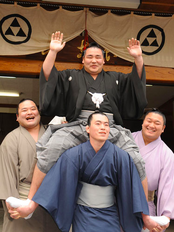
Kakuryu celebrates promotion to ozeki (c. 2012)
In the March 2012 tournament held in Osaka, Kakuryu defeated Hakuho for the second time in a row on Day 9, and entered the final day of the tournament one win ahead of the yokozuna at 13–1, his only loss thus far being to Kisenosato on Day 8. However, he was defeated by Goeido, and Hakuho's defeat of Baruto ensured a playoff between the two Mongolians. Hakuho gained revenge on Kakuryu to claim his 22nd tournament title. Although he missed out on his first championship, Kakuryu received prizes for Outstanding performance and Technique. Kakuryu said that inexperience cost him in his playoff against Hakuho and that a tournament victory was "too soon for me." Kakuryu's 33 wins over three tournaments was, however, enough to grant him a promotion to ozeki. The promotion marked the first time there were six active ozeki simultaneously. It took him 62 tournaments from his professional debut to make ozeki, which was the tenth slowest in sumo history, and the slowest of the nine foreigners who have made the rank.
Yokozuna Career[]
After an unremarkable 2013, in which he scored no better than ten wins in any of the six tournaments, Kakuryu surprised many observers with a 14–1 performance in January 2014, defeating Hakuho in their regulation match and only losing the title in a playoff against him on the final day. It was the fourth runner-up title of his career. He followed it up with a 14–1 record in March 2014, defeating both Hakuho and Harumafuji en route to the Spring Grand Sumo Tournament title. It was his first top division yusho. Having satisfied the minimum requirement of two consecutive championships or "the equivalent", the Yokozuna Deliberation Council unanimously recommended his promotion on 24 March, which was confirmed by the Japan Sumo Association on 26 March. Kakuryu was the first to achieve the rank since Harumafuji in 2012, the fourth Mongolian to do so, the sixth foreign-born yokozuna, and 71st overall. "I am determined to focus all my efforts to train even harder and be certain to give all my strength not to defile the yokozunaname," he remarked. As a yokozuna, he performs the Unryu-gata style.

His first tournament as a yokozuna ended in disappointment as he gave up an early kinboshi to Endo on Day 4 and lost his last three matches to finish on 9–6. He fared better in subsequent tournaments in 2014, scoring at least 11 wins in each, and was in contention for the November 2014 tournament championship before losing to Hakuho in the final bout. This was his fifth career runner-up performance.
Kakuryu was forced to withdraw on the eve of the March 2015 tournament, after suffering a torn rotator cuff in his left shoulder. This was his first absence as a yokozuna and came so late that his opening match had already been drawn up and had to be forfeited. He also sat out the summer Natsu basho in May as the injury had not fully healed, the first time a yokozuna has missed two full tournaments in a row since Musashimaru missed three in 2003. He made a respectable comeback in the July tournament, scoring 12–3 and being in contention for the championship until his defeat to Hakuho on the final day. With Harumafuji absent and Hakuho pulling out on the third day, Kakuryu was the only yokozuna for most of the September tournament. He recovered from losses to Yoshikaze on day 2 and Myogiryu on day 10 to enter the final day on 12–2, one win ahead of the ozeki Terunofuji. In the final scheduled match of the tournament, he was beaten by Terunofuji but won the ensuing playoff by uwatedashinage to take his second championship and his first since his promotion to yokozuna. After the playoff he commented; "The fact that I have long been away from a title has weighed on me. It was tough... I thought I might lose a title once again, but then I came to think that all I needed to do was to execute my style of sumo... I feel rewarded for continuing to work hard without getting down on myself." Despite his success he received some criticism for using the henka, a side-stepping technique, during the tournament, notably against Kisenosato on the penultimate day. In November he never looked likely to win the tournament but ended with a 9–6 record after beating Hakuho on the final day.
Kakuryu began 2016 with 10–5 records in January and March, and did slightly better in May with an 11–4 record. He withdrew from the July 2016 tournament in Nagoya after suffering injuries to his lower back and left ankle. He returned in September and recorded ten wins. In the November tournament he won his first ten matches before losing to Kisenosato on day 11. He rebounded to beat Kotoshogiku and Hakuho before securing his third yusho with a win over Goeido on day 14. After rounding off his tournament with a win over Harumafuji on the final day he commented "It’s really pleasing, I’ve been struggling with injuries for the past one, two years and physically and mentally things didn’t come together, but I didn’t sulk and it’s great that things turned out like this. I feel I’m finally getting to wrestle my way, relaxed. I’ll not forget how I’m feeling now and keep working."

2017 began disappointingly as Kakuryu suffered five defeats in the first ten days, including three kinboshi given up to maegashira ranked wrestlers. Kakuryu withdrew after Day 10 from the tournament with an injury to his right leg. He returned with ten wins in the Osaka tournament in March. He pulled out of the May 2017 tournament after three losses in the first four days, citing a left ankle injury. He also withdrew from the following tournament in July on Day 4, this time with an injury to his right foot. His stablemaster Izutsu said that Kakuryu would not pull out of a tournament upon his return and would have to retire instead – "If he can’t win next time he steps on the dohyo, there will be no option to pull out midway. He would have to take the decision (to retire from the sport) as a man." On September 7, 2017 Izutsu Oyakata confirmed that Kakuryu would miss the Aki tournament as he has yet to recover from his right foot injury. In November he was again forced to withdraw shortly before the tournament, this time owing to a lower back problem in addition to his ankle injury. On December 20, 2017 the Sumo Association announced that he was being docked his salary for January 2018 for failing to act when Mongolian wrestler Takanoiwa was injured by Harumafuji at a restaurant and bar in Tottori in October. Fellow yokozuna Hakuho was docked a month and a half's pay. The chairman of the Yokozuna Deliberation Council said, "Hakuho and Kakuryu were not able to stop the incident from happening and being taken too far. Their responsibility should not be taken lightly. They should be given a strong warning."

Kakuryu with his sixth top division championship (c. 2019)
Kakuryu made his comeback at the January 2018 tournament. After winning his first ten bouts, he then lost four in a row, but won on the last day to finish in third place with an 11–4 record. He was the only yokozuna to complete the tournament after Hakuho and Kisenosato withdrew with injuries. Having felt pain in his left ankle towards the end of the tournament, he underwent surgery in early February to remove loose cartilage. In the March 2018 Tournament, Kakuryu was once again the only yokozuna to compete. He won 11 straight days, before suffering defeat in his match against Tochinoshin. Kakuryu then won his next two matches, and ensured his tournament championship in his win against Goeido on day 14. On day 15 Kakuryu faced Takayasu, the initial ruling was that Kakuryu had won, however a judge's conference was called to review the ruling since it had been close. They decided to have a rematch since Kakuryu's heel had gone out at the same time that the top of Takayasu's foot touched the ring. In the rematch, Takayasu won. Kakuryu finished the tournament with a 13–2 record, this was his fourth championship. In the May 2018 tournament Kakuryu won consecutive championships for the first time, losing only to maegashira Shohozan and finishing one win ahead of Tochinoshin with a 14–1 record. However he pulled out of the following tournament in July through injury on Day 6. In September he appeared to be in excellent form and won his first ten bouts but after losing to Tochinoshin on day 11,he failed to win again and ended with a 10–5 record. He did little training in the run-up to the November 2018 tournament, affected by the right ankle injury that he first suffered in July 2017. He confirmed on November 8 that he would be withdrawing from the tournament. The same injury resulted in him pulling out of the January 2019 tournament on Day 6 with a 2–3 record. After 10-5 and 11-4 records in the March and May tournaments, Kakuryu won his sixth career top division championship in the July tournament with a 14–1 record. Kakuryu clinched the yusho with a final-day win over fellow yokozuna Hakuho.

Kakuryu defeats Hakuho to win his sixth yusho (c. 2019)
In the September 2019 tournament he won his first four matches but lost three in a row to maegashira Asanoyama, Daieisho and Tomokaze and withdrew on Day 8 because of a left knee injury. He moved to the Michinoku stable after the tournament, following the death of his stablemaster Izutsu Oyakata, the former Sakahoko. He withdrew on the morning of the opening day of the Kyushu tournament in November after suffering a back injury in training. He pulled out on Day 5 of the January 2020 tournament with a record of one win against three losses, the third straight tournament he has failed to complete.
Kakuryu was designated as yokozuna-ozeki on the March 2020 banzuke after just one other wrestler remained at the ozeki rank. It was the first time in 38 years that the yokozuna-ozeki designation was used. He was a runner-up for the eighth time in this tournament with a 12–3 record, but pulled out of the next tournament in July on Day 2 with an elbow injury after injuring himself in his opening match, a defeat to Endo Shota. He was absent from the following September tournament as well and his stablemaster said, "We've reached a stage where the question of retirement cannot be avoided. He announced that he would miss the November tournament due to his long-standing lower back injury. This was his sixth withdrawal in his last seven tournaments.
Following the November 2020 basho, Kakuryu - along with fellow yokozuna Hakuho - were issued warnings by the Sumo Association's Yokozuna Deliberation Council due to lack of participation in recent sumo tournaments. This is the middle of three notices that the council can issue between a letter of encouragement and a recommendation for retirement. It is the first time in history that warning notices have been issued.
Retirement from Sumo[]

Kakuryu with his wife after his retirement ceremony (c. 2023)
Despite having previously been warned, Kakuryu withdrew from the January 2021 tournament due to lower back issues. According to his stablemaster Michinoku, Kakuryu said he would be putting his career on the line at the next tournament, and said he would be working to regain his fitness so that he could resume training as early as possible. Having withdrawn from four straight tournaments, Kakuryu initially told reporters that he would compete in March, but withdrew the following week because of a muscle strain in his left leg. His stablemaster said that he was not planning to retire.
Facing a potential of further condemnation by the Yokozuna Deliberation Committee, Kakuryu submitted his resignation to the Japan Sumo Association on March 24, 2021. Kakuryu spoke to reporters of feeling relieved and freed by his decision to retire. He retired with six Emperor's Cups and a makuuchi record of 645 wins and 394 losses. He at first retained his shikona (wrestler name) upon becoming a sumo elder, which he is entitled as a former yokozuna to do for a period of five years pending his acquisition of full elder stock. After almost 3 years since retirement, the JSA announced Kakuryu had adquired the available Otowayama elder stock and was approved to open his own training stable, which effectively opened for the January 2024 tournament.
Kakuryu's danpatsu-shiki (retirement ceremony) was held on 3 June 2023 at the Ryogoku Kokugikan. Kakuryu performed his final yokozuna dohyo-iri, or ring entering ceremony, with former ozeki Shodai and newly-promoted ozeki Kirishima serving as the tsuyuharai (dew sweeper) and tachimochi (sword bearer), respectively. Some 380 people took turns in cutting Kakuryu's oichomage, including all four of the other yokozuna from Mongolia: Asashoryu, Harumafuji, Hakuho and Terunofuji.
Personal Life[]
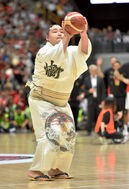
Kakuryu shows off his form at the 2019 FIBA World Cup
- In January 2015 Kakuryu announced his engagement to a fellow Mongolian, Dashnyam Munkhzaya. Their first child, a daughter, was born in May 2015, their second, a boy, in May 2017, and their third, a girl, in April 2020. Their wedding reception was held in October 2017, with fellow yokozuna Hakuho among the guests.
- Kakuryu's hobbies is watching sports and playing golf. Kakuryu also played basketball as a child, and a clip of him swishing a three pointer on his second try with perfect form during the 2019 FIBA World Cup went viral. His favorite foods is yakiniku, kimchi, and natto.
- Kakuryu was born in Ulan-Bator, but his shusshin, or hometown, is listed as Sükhbaatar, which is his father's hometown.
- Kakuryu is known for his gentle and polite demeanor. He has a modest personality and doesn't show too much emotion. Most sumo wresters arrive to the stadium by taxi or cars, but Kakuryu would sometimes prefer to walk alone. However Kakuryu's personality can quickly change once he loses on the dohyo and on many occasions would groan or show his displeasure among reporters.
- In December 2020 Kakuryu obtained Japanese citizenship after a two and a half year process, which is a requirement for staying in the Sumo Association after retirement as an elder.
- Kakuryu learned Japanese through Japanese TV programs and karaoke. He is also fluent in English and Russian.
Fighting Style[]
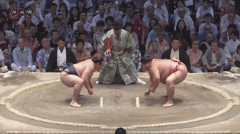
Kakuryu defeats Chiyotairyu by susoharai (rear foot sweep)
In 2006, at the beginning of his top division career, Kakuryu was one of the lightest men in the division at around 130 kg (290 lb). He made use of his agility by frequently employing henka (sidestepping) to outwit his opponents. He has steadily put on weight, however, and at the time of his yokozuna promotion was around 154 kg (340 lb). He prefers yotsu-sumo, a style which involves grabbing the opponent's mawashi, or belt, and forcing or throwing him to the edge of the ring. His favoured grip is migi-yotsu, with his left hand placed outside and right hand inside his opponent's arms. His three most common winning techniques are yori-kiri, the force out, oshi-dashi, the push out, and hataki-komi, the slap down. He is also fond of shitatenage, the underarm throw.
Record[]
Division Results[]
- Total: 785-497-231/1270 (115 basho)
- Makuuchi: 645-394-231/1027 (85 basho)
- Juryo: 41-34/75 (5 basho)
- Makushita: 32-24/56 (8 basho)
- Sandanme: 38-32/70 (10 basho)
- Jonidan: 24-11/35 (5 basho)
- Jonokuchi: 5-2/7 (1 basho)
Championships[]
- 6 Makuuchi Championships
- 1st (March 2014)
- 2nd (September 2015)
- 3rd (November 2016)
- 4th (March 2018)
- 5th (May 2018)
- 6th (July 2019)
- 1 Sandanme Championship (July 2004)
Achievements[]
- Special Prizes: Technique Prize (7), Outstanding Performance Prize (2)
- Record: 10th Most Tournaments Ranked as Yokozuna
Shikona History[]
- Kakuryu Rikisaburo (2001.11 - 2021.03)





















